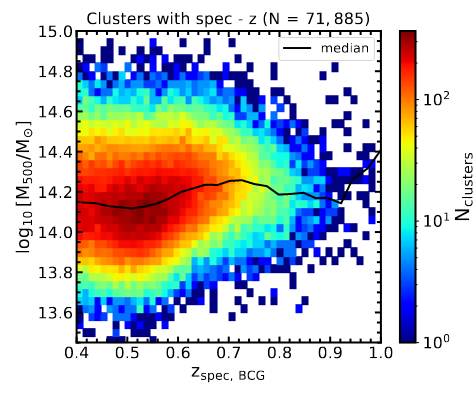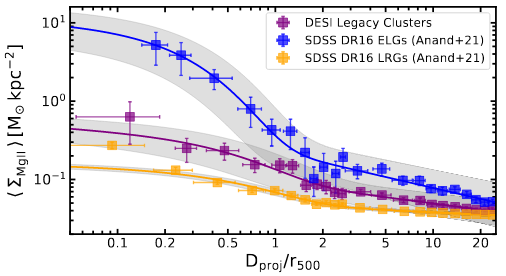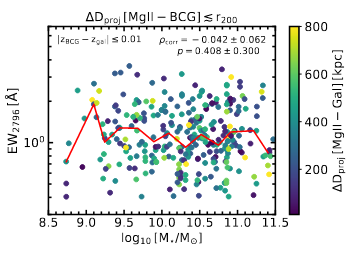The nature of MgII absorbers in DESI clusters
See my paper for details (Anand et al. 2022).
Summary
 In this work, I extended the MgII cold gas correlation to galaxy
clusters identified in the DESI legacy imaging surveys. In this high mass regime (see Figure on left) we have the potential to shed light
on the role of environment in shaping the CGM of galaxies. Cluster
halo gas known as the intracluster medium (ICM) is heated up to
high temperatures (T ~ 107 - 108 K) due to gravitational collapse. In
addition, outflows powered by supermassive black holes in the centre
of clusters can also heat the gas. The hot ICM emits mostly at X-ray wavelengths
due to radiation from thermal bremsstrahlung produced in the highly
ionized gas. Although the ICM is hot, cold/cool gas has sometimes been detected in and around clusters.
The most frequently observed elements are hydrogen (Hα, Lyα)
and metal absorption lines (MgII, OVI),
which are detected in the spectra of background quasars.
In this work, I extended the MgII cold gas correlation to galaxy
clusters identified in the DESI legacy imaging surveys. In this high mass regime (see Figure on left) we have the potential to shed light
on the role of environment in shaping the CGM of galaxies. Cluster
halo gas known as the intracluster medium (ICM) is heated up to
high temperatures (T ~ 107 - 108 K) due to gravitational collapse. In
addition, outflows powered by supermassive black holes in the centre
of clusters can also heat the gas. The hot ICM emits mostly at X-ray wavelengths
due to radiation from thermal bremsstrahlung produced in the highly
ionized gas. Although the ICM is hot, cold/cool gas has sometimes been detected in and around clusters.
The most frequently observed elements are hydrogen (Hα, Lyα)
and metal absorption lines (MgII, OVI),
which are detected in the spectra of background quasars.
 Despite the hot ICM, our analysis shows a significant covering fraction (3-5%) of
cold gas (T ~ 104, traced by MgII absorbers)
in cluster environments on virial scales. On the other hand, the surface mass density (see Figure on right) of MgII absorbers
is 2-3 times higher in clusters than luminous red galaxies (LRGs). However, the surface mass density is 5-10 lower than emission-line galaxies (ELGs).
While the covering fraction of cool gas in clusters decreases with increasing mass of the central galaxy,
the total MgII mass within r500 is nonetheless ~ 10 times higher than for SDSS
LRGs. The MgII covering fraction/surface mass density versus impact parameter is well
described by a power law in the inner regions and an exponential function at larger distances.
The characteristic scale of the transition between these two regimes is smaller for large equivalent width absorbers (EW > 1A),
implying sifferent origin of weak and strong absorbers in dense environments.
Despite the hot ICM, our analysis shows a significant covering fraction (3-5%) of
cold gas (T ~ 104, traced by MgII absorbers)
in cluster environments on virial scales. On the other hand, the surface mass density (see Figure on right) of MgII absorbers
is 2-3 times higher in clusters than luminous red galaxies (LRGs). However, the surface mass density is 5-10 lower than emission-line galaxies (ELGs).
While the covering fraction of cool gas in clusters decreases with increasing mass of the central galaxy,
the total MgII mass within r500 is nonetheless ~ 10 times higher than for SDSS
LRGs. The MgII covering fraction/surface mass density versus impact parameter is well
described by a power law in the inner regions and an exponential function at larger distances.
The characteristic scale of the transition between these two regimes is smaller for large equivalent width absorbers (EW > 1A),
implying sifferent origin of weak and strong absorbers in dense environments.
 Cross-correlating MgII absorption with photo -z selected cluster member galaxies
from DESI reveals a statistically significant connection. The median projected distance
between MgII absorbers and the nearest cluster member is ~200 kpc, compared to
~500 kpc in random mocks with the same galaxy density profiles. We do not find
a correlation between MgII strength and the star formation rate of the closest cluster neighbour (See figure on left).
This suggests that cool gas in clusters, as traced by MgII absorption, is:
(i) associated with satellite galaxies, (ii) dominated by cold gas clouds in the intracluster medium, rather
than by the interstellar medium of galaxies, and (iii) may originate in part
from gas stripped from these cluster satellites in the past.
Cross-correlating MgII absorption with photo -z selected cluster member galaxies
from DESI reveals a statistically significant connection. The median projected distance
between MgII absorbers and the nearest cluster member is ~200 kpc, compared to
~500 kpc in random mocks with the same galaxy density profiles. We do not find
a correlation between MgII strength and the star formation rate of the closest cluster neighbour (See figure on left).
This suggests that cool gas in clusters, as traced by MgII absorption, is:
(i) associated with satellite galaxies, (ii) dominated by cold gas clouds in the intracluster medium, rather
than by the interstellar medium of galaxies, and (iii) may originate in part
from gas stripped from these cluster satellites in the past.